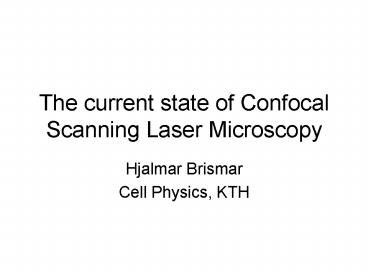The current state of Confocal Scanning Laser Microscopy - PowerPoint PPT Presentation
1 / 47
Title:
The current state of Confocal Scanning Laser Microscopy
Description:
The current state of Confocal Scanning Laser Microscopy Hjalmar Brismar Cell Physics, KTH What are we doing in Cell Physics Confocal microscopy History Present ... – PowerPoint PPT presentation
Number of Views:387
Avg rating:3.0/5.0
Title: The current state of Confocal Scanning Laser Microscopy
1
The current state of Confocal Scanning Laser
Microscopy
- Hjalmar Brismar
- Cell Physics, KTH
2
- What are we doing in Cell Physics
- Confocal microscopy
- History
- Present
- Applications
- Areas of development
- Excitation
- Detection
- Scanning
3
Cell Physics
- Study the biological cell from a physical
perspective - Use tools and concepts from physics on biological
problems - Develop methods and techniques
- Describe biological functions and systems within
a physical/mathematical framework - We focus on
- Cell volume
- Osmolyte transport
- Water transport
- Cell mass
- Measurement techniques
- Cell cycle/cell mass regulation
- Intracellular signalling
- Frequency modulated Ca2 signals
4
Instrumentation
- Microscopy (widefield, confocal, multiphoton)
- Fluorescencent probes
- Fluorescent labels, antibodies
- Genetically engineered, GFP
- Electrophysiology
- Patch clamp
- MEA, multi electrode arrays
5
Confocal microscopy
- Marvin Minsky, 1955
- Laser (1958)1960
- Affordable computers with memory gt 64kB
- CSLM 1986-87
6
(No Transcript)
7
(No Transcript)
8
Widefield
Confocal
9
Confocal evolution
- 1 st generation CSLM (1987)
- 1 channel fluorescence detection
- 50 Hz line frequency
- 2nd generation (commercial systems ca1990)
- 2-3 channel detection
- gt100 Hz
- 3rd generation (1996)
- 4 channel detection
- 500 Hz
- 4th generation (2001)
- 32 channels
- 2.6 kHz
- AOM, AOBS control
10
Confocal industry
- Carl Zeiss (physiology, dynamic measurements)
- Leica (spectral sensitivity)
- Biorad (multiphoton)
- (olympus)
- (nikon)
- (EGG Wallac)
11
Zeiss 510
12
Zeiss 510 Spectra Physics Millenia X - Tsunami
13
Leica TCS SP
14
Leica TCS SP Spectra Physics 2017UV
15
Applications - Techniques
- GFP
- FRAP
- FRET
- Multiphoton excitation
16
GFP- Green Fluorescent Protein
Aequoria Victoria
17
GFP
- Discovered 1962 as companion to aequorin
- Cloned 1992, expression 1994
- 238 Aminoacids
- 27-30 kDa
- Fluorophore made by 3 aminoacids (65-67)
protected in a cylinder
18
Dynamics
GFP-Tubulin in Drosophila
19
Protein mobility bleaching experiments
FRAP Fluorescence recovery after photbleaching
20
Variants of FP
- Blue BFP
- Cyan CFP
- Green GFP
- Yellow YFP
- Red DsRedHcRed
- GFP timer
CFP YFP
CFP GFP
21
Fluorescence Resonance Energy Transfer FRET
Donor
Acceptor
- Spectral overlap
- Distance lt10 nm
22
Interaction - FRET(Fluorescence Resonance Energy
Transfer)
Excitation 430-450 nm
Donor
CFP
ProteinA
lt 5-10 nm
Emission gt570 nm
YFP
Acceptor
ProteinB
23
FRET NKA IP3R
24
NKA IP3R
After
Before
Photobleaching ofacceptor removes FRETdetected
as increased donor signal Distance lt 12
nm Ouabain binding to NKAshortens the distance
stronger interaction increased FRET
efficiency15-25
Donor GFP-NKA
Donor diff
Acceptor Cy3-IP3R
25
FRET based Ca2 sensor
26
Multiphoton excitation
2-photon
1-photon
27
Builtin confocality
1-photon
2-photon
28
Konfokal
Multifoton
PMT
PMT
29
0
20
80 mm
Better penetration (2-400 mm) Enables
measurements from intact cells in a proper
physiological environment. Electrophysiology
40
60
80
1-photon
2-photon
30
FRET CFP-YFP multiphoton
CFP YFP separated by a 6 aminoacid
linker Fluorochrome distance 5 nm
2-photon _at_ 790 nm
2-photon _at_ 790 nm
790
790
YFP Calcyon No excitation at 790 nm YFP excited
at 880 nm
790
880
2-photon _at_ 790 nm
1-photon _at_ 514 nm
31
Development - Excitation
- Currently used lasers
- Ar ion, 458,488,514 nm
- HeNe 543, 633 nm
- Ar ion 351,364 nm
- ArKr 488,568 nm
- HeCd 442 nm
- Diode 405 nm
- HeNe 594 nm
- Multiphoton excitation, TiSa 700-1100
- We need affordable, low noise, low power
consumption lasers - 370-700 nm !
32
Development - Detection
- Spectral separation
- Optical filters
- Prism or grating
- Detectors
- PMT
- Photon counting diodes
- We need higher sensitivity, QE !
33
Development - Scanning
- Speed
- Flexibility
34
Ultrafast 3D spline scan
- Biological motivation
- Ca2 signals
- Measurement approach
- Intracellular ion measurements
- Combined electrophysiology
35
Frequency modulated Ca2 signals
36
Data from live cell experiments combined with
biochemical data is used as input for
mathematical modeling-simulations
Models verified by experiments can provide new
information and direct the further investigations
37
Approach
- High resolution 3D recording of Ca2
- High speed recording
- Combined CSLM - electrophysiology
- Big cells hippocampal pyramidal neurons
38
Scan speed
39
Confocal - line scan
- High time resolution (ms)
- Scan geometry ? cell geometry
- 2D cell cultures
2 s.
40
Arbitrary scan 2D
(Patwardhan Åslund 1994)
41
2D specimen
42
Tissue 3D cells
43
3D arbitrary scan
z
y
x
44
Design criteria
- Z-axis precision gt optical resolution
- Bidirectional scan (to gain speed)
- Focusing distance 20-50 um
- gt100 Hz
- Nonharmonic
45
Ideas for ultrafast 3D scan
- Stage scan
- High mass, impossible patch clamp
- Scan objective
- Well defined mass, side effects in specimen ?
- Scan focusing lens inside objective
- Tricky optics ?
46
Piezo focus with specimen protection
V/I
47
(No Transcript)































